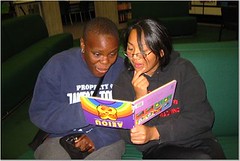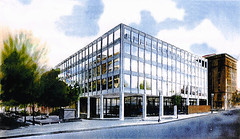DC Central Library article in the Intowner
 Just like you can't read a book upside down, you can't put more facilities and programs in a space that's at least 1/3 smaller than the current space, no matter how well designed. New Zealand photo from the women's rugby team at Stanford University.
Just like you can't read a book upside down, you can't put more facilities and programs in a space that's at least 1/3 smaller than the current space, no matter how well designed. New Zealand photo from the women's rugby team at Stanford University.Speaking of Laura Bush, who because she came to an event sponsored by the DC government about libraries, Mayor Williams thinks the federal government will give a lot of money to DC to build a new central library, the current issue of the Intowner, the community newspaper of the city's midtown neighborhoods, has an excellent (and long) piece by Anthony Harvey about the library hearing last month. It should be online by Monday.
The one thing it missed, something I missed as well in my testimony (but added to blog writings), is that the proposed new Central Library is significantly smaller than the current MLK Library, and significantly smaller than new central libraries that have been built recently in other cities such as Seattle, cities that DC has compared itself to in the library planning process.
Given the debacle of the new San Francisco Public Library having to throw out ("discard") at least 100,000 books because they didn't allocate enough space for book storage, this is scary.
It's the number one reason why I can't support the construction of a new facility, at least as is currently proposed. "Smaller but better" won't work.
All kinds of people suggested adding facilities. One person at the hearing called for a symphonic-quality auditorium. I suggested combining archives, city museum functions, and suggest that DC offer space to the Foundation Center to move their currently separate library into a "new" library, etc. (See "Central Library Planning efforts and the City Museum, how about some learning from Augusta, Maine, and Baltimore...?")
There's no way that the library program can be expanded with the currently proposed new central library. In fact, the program will have to be reduced.
Like most library users and employees, I don't like the current facility. But if it can be rehabilitated, maybe that's the best course, if only for space reasons. I know that the AIA Washington proposal calls for adding one new floor, but I say if they are going to carve out a goodly portion of the interior for an atrium, add two floors. Books aren't going away anytime soon, even if DC has an incredibly high illiteracy rate.
 Rendering of a remodeled and expanded Martin Luther King Library, DC Library Renaissance Project.
Rendering of a remodeled and expanded Martin Luther King Library, DC Library Renaissance Project.I guess one of the reasons that for the most part, modernist architecture doesn't appeal to me is because of the strong association of the movement with urban renewal.
Index Keywords: libraries



0 Comments:
Post a Comment
<< Home